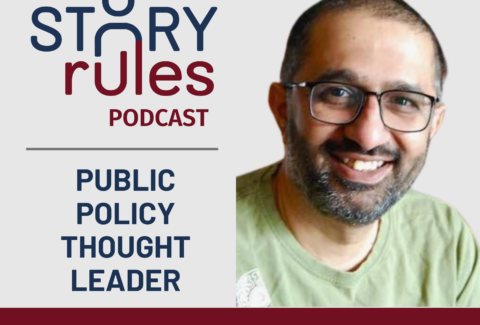A framework to test opinions and win arguments (Part 2)
Here’s wishing all of you a Merry Christmas and a safe, memorable and fun New Year celebration ahead!
In last week’s post, I shared a foundational framework for testing the strength of your opinions.
Here’s a quick summary as a recap:
- When we state an opinion or recommendation it is really a Conclusion, based on some (unexpressed) Minor Premise and Major Premise
- In order to test the soundness of our opinion, we should put down our thoughts in the Deductive Reasoning template (Major Premise – Minor Premise – Conclusion)
- We should then carefully look for evidence that contradicts the Major Premise and Minor Premise
- If we do end up finding contradictory evidence, but we still believe in our Conclusion, we should share the finding with our audience and give them a sense of the probability of our conclusion being right (i.e. show humility).
- Finally, the goal is not to find the 100% certain answer, but to be genuinely curious and keep looking to improve the odds of success.
Alright, now let’s take this model out for a test drive.
Test-driving the framework with some real opinion pieces
I’ve chosen two opinion pieces by respected thinkers. Here’s the first one:
1. ‘Why farmers won, government lost’ by D Subbarao, former Governor, Reserve Bank of India
In this fascinating article (PDF of the article for those who can’t access it behind the paywall), the former RBI Governor makes the following points:
a. The farm laws were good for the majority of the country:
“Economic reforms produce winners and losers. In the case of farm laws, losers were the relatively large farmers with a marketable surplus, who feared losing the protection of the minimum support price (MSP). On the other side, potential winners were the larger public who would have benefitted by way of a cleaner environment and lower agricultural prices as market forces gradually engineered a shift in production from cereals to cash crops. The public would have benefitted too, albeit less obviously, via the alternate use of the money saved on MSP – better schools and health facilities, for example.”
b. Despite the potential gains (and winners) being significantly more, the reforms didn’t go through because of mismatched incentives and power equation between winners and losers:
“In theory, any reform measure where the winners gain more than the losers lose should sail through. In practice things hardly ever work out that neatly. Many real world factors – interest group dynamics, biases and even misinformation – come in the way of the best policies getting through.
Consider for example the unequal incentives of winners and losers to mobilise and agitate for their cause. In the case of farm laws, farmers were a relatively small group, united by a single cause, each of them losing heavily if the reform went through. On the other side, benefits of the reform would have spread thinly across the vast public; for any single individual, the reward was small, the cost of getting organised high, and the incentive to agitate quite low. In the absence of any effort to mobilise the larger, amorphous group behind its interest, the smaller group held sway.
The play-off between winners and losers is also complicated by the time dimension. For farmers, the cost if the reform went through would be immediate which therefore galvanised them into action. For the public on the other side, benefits of reform, although cumulatively substantial, would accrue over time.”
c. In such situations, the government needs to invest significant effort in communication and consultation:
Based on the above two points, Mr. Subbarao comes to his main conclusion:
“To promote the larger public good therefore, governments need to invest effort into communication and consultation to prevent the debate getting hijacked by a narrow interest group.”
d. He then gives an example of an excellent past example where the government had invested in clear communication and consultation
“Back in the mid-1990s, in the Andhra Pradesh government, we were confronted with a serious resource crunch that called for politically painful expenditure restructuring. We had to chop many subsidies including raising the price of subsidised rice – the government’s flagship scheme.
Chandrababu Naidu, the CM at the time, agonised over it quite a while and then, instead of deciding on the issue right away, suggested that we put out a white paper explaining the financial situation and the difficult choices the government had to make.
Frankly, I thought this was all a waste of time since common people will not understand public finances, and in any case, they will not support a measure that would directly hurt them. How wrong I was! Naidu, politically savvy as he had always been, organised extensive dissemination of the white paper both through the government machinery and his party structure.
In several focus group meetings, I heard ordinary people, whose understanding I had underestimated, ask if they would get better roads or drinking water in their village from the money saved on the subsidy. After weeks of this, I can’t say there was total support for the subsidy cuts but the opposition to them was substantially attenuated.”
Excellent. Now let’s try and apply the Deductive Reasoning template to this article. What is Dr. Subbarao trying to say?
He’s following an “If X, then Y (as a necessary condition)” template:
Major Premise: “If there is a reform measure that is overall beneficial, but can get hijacked by a small but well-organised interest group, then the reformers must invest time and effort in communication and consultation with all parties” (Basically they must tell a good story of the reform, as a necessary, though not sufficient condition)
Minor Premise: “The farm laws were a reform measure that met the above conditions”
Conclusion: “The farm laws needed clear communication and consultation”
How does it help us to formulate his this thesis in this format? Well, now we can stress-test the Major Premise. All we have to do… is to look at all similar reform measures undertaken in all countries across all of time… and see if it meets the Major Premise’s conditions. If we come across several (ok a majority of) instances where the reforms sailed through without proper communication and consultation, we can refute Mr. Subbarao’s claim. Easy peasy.
Phew, feeling humble already?
Sure, we cannot do a true MECE study of all such reform measures ever. But attempting to do some version of that in the Indian context would be a useful exercise, right?
Our original ideas might be right, but by doing this research, we will be in a much more surer position to make that claim.
Now let’s explore the second opinion piece.
2. ‘Piketty’s super-rich tax is not going to end inequality’ by Swaminathan Anklesaria Aiyar, economic columnist
I’m a fan of Swaminomics and have had the privilege of interviewing Mr. Aiyar on my podcast. Here’s the article where he refutes the argument made by Mr. Piketty (and other economists) calling for a global wealth tax in their World Inequality Report 2022.
In this case, Mr. Aiyar is not really stating a conclusion – he is refuting someone else’s conclusion, which goes somehow like this:
Conclusion: We must levy a wealth tax (or additional income tax) on the super-rich to combat high and growing inequality
What would be the Major and Minor Premise for the above? Again, this is not given in the article, but here’s my take:
Major Premise: If there is high and growing inequality, it will lead to increasing global unrest and we must levy a wealth tax (or additional income tax) on the super-rich to tackle it
Minor Premise: The world is seeing high and growing inequality
Conclusion: We must levy a wealth tax (or additional income tax) on the super-rich
In his article, Mr. Aiyar systematically looks for contradictory evidence for each element of the Major Premise. He breaks the statement into three parts:
- There is high and growing inequality
- It will lead to increasing global unrest
- A wealth tax (or additional income tax) on the super-rich will address it
He refutes each part of the Premise separately starting with the first one: Is there really high and growing inequality?
He makes several points to challenge that argument…:
- Extreme poverty exceeded 80% for most of history, but fell to 55% by 1955 and just 8.6 % in 2018
- Famines killed hundreds of millions through history but have almost disappeared
- The UN Multidimensional Poverty Index showed a decline of 271 million poor Indians between 2005-06 and 2015-16
- And finally, he makes a point about the inequality computation not being comprehensive:
“…the US Census Bureau estimates that between 1967 and 2017, income equality in the US spiked up by 21.4%. But these figures failed to adjust for huge government transfers to the masses or taxes paid by the rich. Make those adjustments and the rise in inequality becomes just 2.3%. No apocalypse here.”
…culminating in a key insight:
“Inequality between individuals may have increased but inequality between nations has fallen for the first time since the industrial revolution with developing countries (including China and India) catching up.”
He then takes on the second part: Is it leading to global unrest? He responds with two rebuttals:
- Voters prefer current policies:
“The authors have long shouted themselves hoarse, warning of apocalypse if inequality keeps rising. But far from turning revolutionary, voters in highly unequal democracies keep electing tax-cutters such as Donald Trump, Emmanuel Macron and Narendra Modi”
- People are not significantly unhappier (especially in countries with high inequality)
If rising inequality is really terrible, most people should be unhappy. Yet the UN World Happiness Report says the global average of those very happy or rather happy was an encouraging 64% in 2019, and 63% even in the dreadful Covid year of 2020. This represented a significant fall from 77% in 2011. But high inequality co-existed with high happiness through the decade.
Between 2011 and 2019, happiness on this measure declined from 85% to 79% in the US, from 80% to 75% in Sweden, and from 89% to 77% in India. But it rose from 79% to 82% in the UK and from 76% to 78% in Germany. The overall picture remains highly positive. Remarkably, Trump’s USA in 2019 had a better happiness ratio than socialist Sweden, widely praised for high tax rates to finance welfare.
Finally, he tackles the third part: ‘We must levy a wealth tax (or additional income tax) on the super-rich to tackle it’ – by offering contradictory evidence:
- It hasn’t worked in India:
“India has tried high taxation to end poverty and failed spectacularly. Indira Gandhi’s Garibi Hatao approach included income tax rates of 97.75% and wealth tax of 3.5%: nationalisation of banks, coal, and general insurance; and canalisation of most imports and exports through the public sector. But the poverty ratio did not fall at all between 1947 and 1980, while the population almost doubled. So, the absolute number of poor almost doubled, a terrible outcome. Inequality certainly declined but this hurt rather than helped the poor.”
- It may not work in the US:
“Voters are happy to vote for politicians like Joe Biden who propose higher taxes to fund better childcare, health, college education and infrastructure. But these are modest tax measures. They will not reverse rising inequality, which is fuelled above all by fiscal and monetary stimuli to accelerate economic growth.”
(Mr. Aiyar does pack in a lot of arguments in his 800-word pieces!)
Sure, you may disagree with his assertions. But now you know what to do to refute them – apply the Deductive Reasoning template and stress-test the opinions.
And guess what, you can do that for your debates at the workplace too.
Best to leave it out at home though. The spouse is always right.
Photo by Sebastian Herrmann on Unsplash








